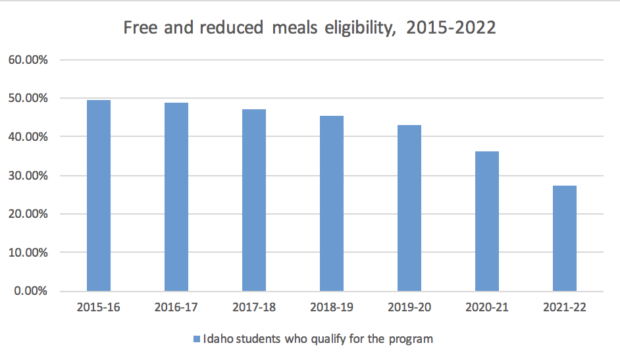An improving economy and nixed paperwork requirements helped cause the number of Idaho children who qualify for government food subsidies to drop by nearly half in recent years.
The average number of Idaho students who qualify for federally funded free and reduced-price meals fell from around 50% to just over 27% since 2015-16, state numbers show.
But that doesn’t mean actual need for the popular subsidy — given to children in households that meet certain income requirements — has diminished by that much.
The U.S. Department of Agriculture provided all students, regardless of their family’s financial status, with free meals during the 2020-21 and 2021-22 school years — a response to COVID-19. The change put free food in front of students across Idaho and the nation during the health crisis, but complicated the picture because schools weren’t required to collect applications or income surveys tied to the federal program.
The lack of requirements during two school years lowered the numbers, State Department of Education spokesperson Maggie Reynolds told EdNews.
Also fueling the decline over the last half decade: an improving economy.
“It is a direct correlation when income rises, the free-and-reduced rate drops,” said Bonneville School District Child Nutrition Director Heather Plain.
Eligibility for free and reduced-price meals is important because it’s a key measure of poverty in public schools. Here’s a closer look at Idaho’s decline in recent years, and what leaders are saying about it.
A steady — then sharp — drop
The number of eligible students for subsidized school meals in Idaho fell from 49.33% in 2015-16 to just 27.26% in 2020-21, a more than 22 percentage point decline.
The drop was steady from 2015-16 to 2019-20, falling just over six percentage points before the pandemic had its heaviest impacts on schools in 2020-21 — a possible indicator of a steadily improving economy’s positive impacts on income levels, which rose between 25% and 32% since 2015, the Idaho Press reported in January.
But then the number dropped sharply while schools grappled with the pandemic and eligibility requirements eased, the numbers show. From 2019-20 to 2020-21, the rate saw its sharpest two-year decline, falling from around 43% to roughly 27%.
The following graph captures the trend over the past seven years, including the more recent, sharper declines:

Similar trends played out locally. Here’s a closer look at what happened in Idaho’s five largest districts, beginning in 2015-16:
| District | 2015-16 eligibility | 2016-17 eligibility | 2017-18 eligibility | 2018-19 eligibility | 2019-20 eligibility | 2020-21 eligibility | 2021-22 eligibility |
| West Ada |
23% |
28% |
25% |
25% |
24% |
18% |
16% |
| Boise |
53% |
52% | 51% | 50% | 39% | 34% | 29% |
| Nampa |
68% |
66% | 64% | 57% | 57% | 45% | 42% |
| Bonneville |
46% |
42% | 38% | 38% | 35% | 29% | 21% |
| Pocatello-Chubbuck |
49% |
48% | 48% | 45% | 43% | 45% | 35% |
‘A variety of factors’
Leaders in Bonneville, Boise and Nampa pointed to an improving economy and nixed federal paperwork requirements as a key driving force behind declines in local eligibility.
But other district-level realities could also be playing a part, to varying degrees, they said.
“A variety of factors” have likely changed Boise’s eligibility landscape, said district spokesman Dan Hollar. He pointed to enrollment declines that have plagued the district in recent years, despite statewide enrollment growth in K-12.
Decreasing enrollment drives “fewer total numbers” of students who qualify, Hollar pointed out. And demographics tied to local population changes are a whole other factor, he added, referencing an increase in the number of “lower income families” he says are moving out of Boise amid local push for gentrification.
An open campus at Nampa High School, which gives students the option to visit fast food restaurants near the school, has impacted the district’s numbers in recent years, said Nampa nutritional service director Michelle Eggers. “This … has resulted in lower free-and-reduced percentages at our largest facilities, which impacts the entire district.”
Reynolds said the State Department is still working with the State Board of Education for a better read out on eligibility for 2020-21.
She expects better numbers next school year — maybe.
“We expect to have better numbers when we return to standard application collection next school year — that is unless congress decides to provide free meals again,” she said, adding that state eligibility rates for the 2022-23 school year will be updated in April of next year.
